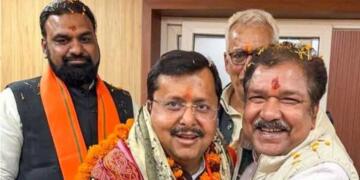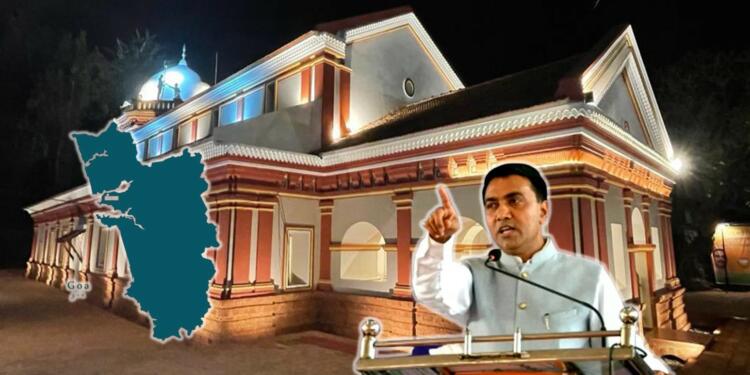Shree Saptakoteshwar Mandir renovation: One of the best things about Hinduism is that it is an excellent mix of liberal and conservative values. The Sanatani traditions are not traditions in the sense of the word we interpret. The traditions do not really die down with time. In one form or the other, they are preserved so that when future generations want, they can recuperate it. To put it simply, things are turned into Ashes but the fire within them is preserved. Hindus’ forefathers have done it for more than 1,500 years.
This is the reason why when people living in places like Goa want to go back to traditional routes, they have enough in their memorial tank to push back. Goans are quickly shedding its European legacy and returning to their Hindu routes. No pint for guessing, it all starts with having a proper, respectful, dignified and peaceful place of worship.
PM Modi congratulates CM Sawant
Recently, PM Modi congratulated the Goa government for successful renovation of the historic Shree Saptakoteshwar Mandir.
Shree Saptakoteshwar Mandir was inaugurated by Chief Minister Pramod Sawant himself. Quoting Sawant’s tweet informing about the 350-year-old Mandir, PM Modi explained that the Mandir will further youth’s progression towards spirituality.
He also hinted that a whole new genre of tourism could open up in Goa. In other words, Goa may become a place for people to gain spirituality.
Quote, “The renovated Shree Saptakoteshwar Devasthan, Narve, Bicholim will deepen the connect of our youth with our spiritual traditions. It will also further boost tourism in Goa.”
The renovated Shree Saptakoteshwar Devasthan, Narve, Bicholim will deepen the connect of our youth with our spiritual traditions. It will also further boost tourism in Goa. https://t.co/b32tNzz9BB
— Narendra Modi (@narendramodi) February 11, 2023
Informing people about the history of Shree Saptakoteshwar Mandir, CM Sawant said that Mandir is more than 1000 years old and its first mention is found in Kadamba Dynasty rule. It was desecrated by Bahamanis, rebuilt by Vijaynagar Empire and again desecrated by Portuguese.
Read more: Goa Statehood Day: The journey of Goa from a colony to an Indian state
It had to be shifted from Naroa to Narve for preservation and the current structure was built by Chhatrapati Shivaji Maharaj. In a tribute to Maharaj Ji, his descendants have been called for religious rituals.
Shri Saptakoteshwar is the 'Raj Daivat' of Goa. The history of temple, originally situated at Naroa, Diwar, Tiswadi, goes back to Kadamba Dynasty rule. It was desecrated by Bahamani rulers, rebuilt during Vijayanagara rule. It was again destructed by Portuguese rule in 1540. 3/5
— Dr. Pramod Sawant (Modi Ka Parivar) (@DrPramodPSawant) February 11, 2023
Fearing the destruction, the temple was shifted to Narve, Bicholim, at present location. The Present temple was built by Chhatrapati Shivaji Maharaj in 1668. His successful campaigns put a check on Portuguese brutalities and religious conversions in Goa. 4/5
— Dr. Pramod Sawant (Modi Ka Parivar) (@DrPramodPSawant) February 11, 2023
The renovation of the temple is done under Goa Archives and Archeology department. During the renovation the 'Kaavi' art form of wall decoration is being executed, to revive the art. 5/5
— Dr. Pramod Sawant (Modi Ka Parivar) (@DrPramodPSawant) February 11, 2023
The temple will be dedicated to the people after performance of due religious rituals and in the presence of descendants of Chhatrapati Shivaji Maharaj. 2/5
— Dr. Pramod Sawant (Modi Ka Parivar) (@DrPramodPSawant) February 11, 2023
Hinduism in Goa
The Shree Saptakoteshwar Mandir is just one of those which is getting its glory back. The fact is that there are thousands of such Mandirs in a desecrated state all across Goa. The reason behind it is that Goa was never what it is today. It was always a geography where Hindus outnumbered any other groups. Even the story of its origins is found in many Hindu literatures.
According to Skand Puran, Bhagwan Parshuram once shot an arrow from western ghats into the sea. He then ordered Samudra Devta to withdraw from the spot and declared that place as his kingdom. The land around Benali, that spot is now known as Goa.
Historical evidences suggest that Goa’s modern habitation dates back towards the end of Vedic period. Saraswati river, the backbone of Indus valley civilization had started to dry and so lots of people looked for alternate sources.
A group of 96 families, known as Gaud Saraswats settled along the Konkan Coast around 1000 BC. Over the next few centuries, a prosperous Hindu Community was thriving there.
For thousands of years, Goa was den of Hinduism
These times brought in different names for the geography. Goa, Gove, Gowapura Gomant, Govarashtra, Goparastra, Govapuri, Gopakpuri, Gopakapattana are some of the famous names recorded in History.
Chandragupta Maurya ruled over Goa in the third century BCE, according to historical documents. The Satavahana dynasty was present, as evidenced by some Satavahana-era pottery discovered in Chandrapur, which dates the city’s likely founding to 200 BCE.
Following the Satavahanas were the Bhojas, who established Chandrapur (now Chandor) as their capital, as shown by the numerous inscriptions discovered. These inscriptions date from the third to the fourth century CE. The Badami Chalukyas were next in line to rule Goa, then the Shilaharas, and finally the Kadambas.
The Kadambas were distinct because they were a regional dynasty that gradually gained control of the region by forming alliances with their Chalukya neighbours and overlords. Their capital became Chandrapur (Chandor) (937 AD to 1310 AD). After that, they relocated to Govapuri, which is now Goa Velha, was located on the banks of the Zuari river.
In the middle of the 11th century, when it was still known as Thorlem Gorem, the Kadambas are credited with building the first settlement on the current site of Old Goa. The time of the Kadambas is regarded as Goa’s first golden age. The last Chalukya king’s death in 1198 weakened their alliance, leaving Goa vulnerable to Muslim invasions that took place in the following centuries.
Abrahamic invasion
The Kadamba Dynasty in Goa was subject to Islamic invasion. Islamists like Malik Kafur, Bahamian Sultans and finally Adil Shah in 1488 AD established Islamic rule. For a brief period between 14th and 15th century, Vijaynagar Empire was there at the top and in fact rebuilt many of Mandirs destroyed by Islamists. However, they lost retreating battle to Bahamnis.
Bahmanis split their kingdom in five parts, one of which was called Bijapur, containing modern-day Goa. When Portugali invasion occurred, they gave Hindus some relief by respecting their culture. But slowly, they started to show their true colours, especially with their inquisition of Goa.
Inquisition and Hindu genocide
The preparation for inquisition had started years before it was actually approved. Portuguese tested waters by punishing Indians for religious crimes like not attending Churches.
In June 1541 an order was passed to destroy Hindu Mandirs and hand over the seize to Christian missionaries operating in Goa.
On March 8, 1546, King John III of Portugal issued an order outlawing Hinduism, destroying Hindu Mandirs, forbidding the observance of Hindu feasts in public.
The order also prescribed expelling Hindu priests, and harshly punishing anyone found guilty of creating any Hindu images.
The official inquisition kicked off in 1560 AD. It was nothing less than systematic oppression of Jews by Hitler and his minions. It became illegal for Hindus to occupy public office. Hindu clerks were replaced by Christians entrusted upon by Portugali authorities.
Hindus sitting at the top of local authorities could not exercise their power without permission from corresponding Christian authorities. It got so absurd that the Portuguese even refused to accept Hindus as witnesses in legal proceedings. Hindu women were lured into Christianity with the promise that by doing so, they would become eligible to become heir of their father’s property. If her child’s Hindu father had died, it became compulsory for her to hand over son to Jesuits for conversion to Christianity.
Systematic oppression of Hindus by Church
Similar to Shree Saptakoteshwar Mandir many Hindu Mandirs were banned from being constructed or maintained, and restrictions were placed on Hindu marriages, rituals, and cremations. Even wearing the sacred thread or planting Tulsi plants was outlawed, and upper-caste Hindus were prohibited from riding palanquins or horses. The Portuguese also sought to forcibly convert the native population, using tactics such as abducting orphans and providing compulsory Christian education to those over the age of 15. Portuguese soldiers would even throw beef at passers-by to force them to become Christian and renounce their Hindu faith. Language is the carrier of any culture but sadly the local language was banned. The use of the Konkani language was becoming prohibited. And all new converts had to adopt Portuguese names and learn the language. Those who failed to meet Christianity’s dogmas were severely punished, with thousands of natives and converts burned at the stake or tortured in the Inquisition’s dungeons.
While exact numbers are unknown due to the destruction of records, surviving individual accounts, such as Charles Dellon’s, paint a picture of the horrific nature of the Goan Inquisition, which brought international notoriety to the region. Till 1566, more than 100 Mandirs were destroyed. Within 1-year, Franciscan missionaries destroyed 300 more Mandirs in North Goa. By 1569, Portuguese officials informed their king that they had razed all Hindu Mandirs to the ground. By the end of the 17th century, only 8 per cent of Goans were non-Christians. Most likely, these numbers are a gross underestimation since the Portuguese burnt most of their records after sending out all Judges from their territories.
Back to the roots
In later years, the Portuguese used this conquest for their own advantage. Their conquest continued for more than 400 years, so much so that even when India took it back, their outcry was invasion of Portuguese land.
Despite India taking it back, Goa’s culture did not change for a large period of time. As the west got nihilistic, Goans kept copying them, making the place a hub of drugs, illicit liquor and other hedonistic stunts. It is in fact one of the favourite tourist spots, not for good reasons obviously.
Things are set to change in upcoming years. For more than a decade, Goans have been choosing those leaders who strive towards upholding Hinduism, a way of life in the state.Part of the reason is that the population of Hindus in Goa is increasing at a staggering pace and BJP has been capitalising on it. Time and again Sawant government has indicated that it is willing to take the rejuvenation projects of destroyed Mandirs. Shree Saptakoteshwar Mandir is one such example. It is in line with larger schemes of things in Bharatvarsh. Ayodhya, Kashi, Mathura, Goa and many more. Hindu renaissance is in full swing. And it is some good news from across the country.
Support TFI:
Support us to strengthen the ‘Right’ ideology of cultural nationalism by purchasing the best quality garments from TFI-STORE.COM































